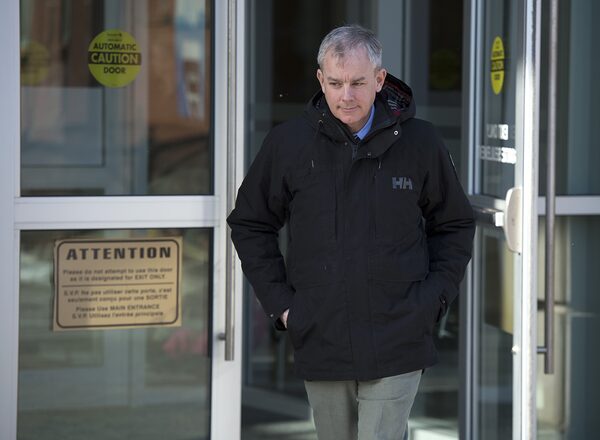
Dennis Oland heads from the Law Courts in Saint John on Jan. 29, 2019.Andrew Vaughan/The Canadian Press
A man working in the building where Richard Oland was beaten to death says he heard a loud crash and thumping noises coming from the murder scene, a Saint John trial was told Wednesday.
And if Anthony Shaw’s “best guess” at a time for those noises is correct, it appears virtually impossible that Dennis Oland could have killed his father.
Mr. Shaw was on the stand Wednesday at Mr. Oland’s second-degree murder trial, a witness called by the prosecution but key to the defence argument that Richard Oland was killed at a time when his only son was shopping at a market some distance away.
Mr. Shaw’s testimony is pivotal to the defence position that Richard Oland, a multimillionaire and member of the Maritime beer-brewing family, was bludgeoned to death between 7:30 and 8 p.m. on the night of July 6, 2011.
That is around the time Mr. Shaw, working in a printing shop beneath Richard Oland’s second-floor office, believes he heard the telltale noises.
“We heard a loud crash and then several quick thumps thereafter. I would say 10 to 12,” Mr. Shaw testified.
When asked what time by Crown prosecutor Jill Knee, Mr. Shaw said “I would guesstimate around 7:30 p.m. It’s my best guess.”
Mr. Oland was caught on video at a market in Rothesay, a suburb of Saint John, at 7:38 p.m. He was shopping with his wife, Lisa, and another relative.
The prosecution position is that Richard Oland was killed closer to 6:30 p.m. on July 6, 2011, at the tail end of a visit by Dennis. Prosecutors say Richard Oland, worth about $37-million at the time of his death, was killed “in a rage” by his son who was on the edge financially and had a strained relationship with his father.
Dennis Oland is the last known person to have seen his father alive.
Mr. Shaw told the court he was working in the Printing Plus office on the night of the murder from 6 to 9. He said he didn’t see anyone coming or going from the Oland office, and the only thing unusual was the loud noises.
He was working at Printing Plus with his friend, John Ainsworth.
“We looked at each other,” Mr. Shaw said, when the two heard the noises. “Then it stopped.”
They did not investigate.
“I figured it could have been someone putting furniture together, or moving things around,” Mr. Shaw said.
Mr. Ainsworth will be called to testify at a later date, but the prosecution has already told the trial he is less certain of the time, saying it was between 6 and 8 p.m.
Mr. Shaw said the only customer that night was a man who came in and sent a fax at around 8 p.m. He said that time is important to his recollection.
“It gave me a reference point,” he said under cross examination by defence lawyer Alan Gold.
Grant Fredericks, who runs Forensic Video Solutions in Spokane, Wash., also was on the stand at the Oland trial on Wednesday.
He looked at surveillance footage from locations in the Saint John area where Mr. Oland was caught on camera in the hours before and after Richard Oland was killed.
Dennis Oland, 50, a former investment adviser, is on trial for the second-degree murder of his father. This is a retrial since Mr. Oland’s conviction in 2015 was set aside on appeal and a new trial ordered.
Mr. Fredericks’s testimony from 2015 was replayed for the current trial. Crown prosecutors and the defence have agreed to reuse testimony from the first trial where possible, to save time and money.
Mr. Fredericks told the court his video search was confined to three items of clothing: a brown jacket, a checkered shirt and a pair of shorts. He compared video footage of Dennis Oland wearing these items on July 6, 2011, with police photos of the items after they were seized and became evidence.
In all cases, Mr. Fredericks could not say if the clothes were the same, only that they had the “same class features” meaning they were similar or the same type.
It is something of a moot point for the trial. Mr. Oland already has confirmed he was wearing the brown jacket and the shirt, although he initially told the police he was wearing a navy jacket on the day of his father’s murder.
His defence lawyers have said it was an “honest mistake.”
The brown Hugo Boss jacket was found to have several small bloodstains on it and DNA that matched Richard Oland’s profile.
Both the jacket and the shirt, which had stains on it that could not be forensically identified, were dry cleaned in the days following the murder.
Under cross examination by defence, Mr. Fredericks said he was not given any other items to compare, including shoes that Mr. Oland may have been wearing.
Police found no blood on any of the eight pairs of shoes in Mr. Oland’s closet.
The crime scene was very bloody. Richard Oland, 69, was struck more than 40 times with an axe-like weapon and a blunt, hammer-type instrument, possibly a dry-wall hammer. A weapon was never found.
The trial continues on Thursday. It is expected to last until mid-March.